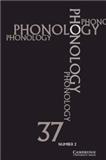
Phonology, as an authoritative publication in the field of phonology, ensures that the academic community has timely access to the latest research findings and discussions with its publication frequency of three times a year. It is not only a venue for academic exchange but also an important force in promoting the development of phonological theory and the innovation of practice. The journal encourages scholars from different theoretical backgrounds to propose new theoretical perspectives and share their research findings, thereby promoting dialogue and integration between different theories.
The research articles published in the journal include not only in-depth theoretical analysis but also a wide range of empirical studies. These studies are often based on a large amount of corpus data, using advanced experimental methods and statistical techniques, providing solid empirical support for the theories of phonology. In addition, the book review section of the journal provides readers with an in-depth interpretation of the latest academic works, helping scholars understand and evaluate new books and important literature in the field of phonology.
At the same time, the journal Phonology also pays attention to hot issues and controversial topics in phonology. By publishing short articles and comments, it provides scholars with a channel to express their views and exchange ideas. These discussions help to clarify concepts, resolve disagreements, and promote in-depth thinking by the academic community on relevant issues.Through these comprehensive contents, the journal Phonology not only provides rich academic resources for phonological researchers but also provides interdisciplinary perspectives and inspiration for scholars in related disciplines such as linguistics, psychology, and computer science, promoting exchange and cooperation between different disciplines.
《Phonology》是一本由Cambridge University Press出版商出版的專業(yè)文學期刊,該刊創(chuàng)刊于1984年,刊期4 issues/year,該刊已被國際權威數(shù)據(jù)庫SCIE、SSCI收錄。在中科院最新升級版分區(qū)表中,該刊分區(qū)信息為大類學科:文學2區(qū),小類學科:語言與語言學 2區(qū);語言學 3區(qū);在JCR(Journal Citation Reports)分區(qū)等級為Q3。該刊發(fā)文范圍涵蓋LANGUAGE & LINGUISTICS等領域,旨在及時、準確、全面地報道國內外LANGUAGE & LINGUISTICS工作者在該領域取得的最新研究成果、工作進展及學術動態(tài)、技術革新等,促進學術交流,鼓勵學術創(chuàng)新。2023年影響因子為0.7,平均審稿速度 。
中科院分區(qū)(當前數(shù)據(jù)版本:2023年12月升級版)
| 大類學科 | 分區(qū) | 小類學科 | 分區(qū) | Top期刊 | 綜述期刊 |
| 文學 | 2區(qū) | LANGUAGE & LINGUISTICS 語言與語言學 LINGUISTICS 語言學 | 2區(qū) 3區(qū) | 否 | 否 |
中科院分區(qū)(當前數(shù)據(jù)版本:2022年12月升級版)
| 大類學科 | 分區(qū) | 小類學科 | 分區(qū) | Top期刊 | 綜述期刊 |
| 人文科學 | 3區(qū) | LINGUISTICS 語言學 | 3區(qū) | 否 | 否 |
中科院分區(qū)(當前數(shù)據(jù)版本:2021年12月舊的升級版)
| 大類學科 | 分區(qū) | 小類學科 | 分區(qū) | Top期刊 | 綜述期刊 |
| 人文科學 | 4區(qū) | LINGUISTICS 語言學 | 4區(qū) | 否 | 否 |
中科院分區(qū)(當前數(shù)據(jù)版本:2021年12月升級版)
| 大類學科 | 分區(qū) | 小類學科 | 分區(qū) | Top期刊 | 綜述期刊 |
| 人文科學 | 4區(qū) | LINGUISTICS 語言學 | 4區(qū) | 否 | 否 |
中科院分區(qū)(當前數(shù)據(jù)版本:2020年12月舊的升級版)
| 大類學科 | 分區(qū) | 小類學科 | 分區(qū) | Top期刊 | 綜述期刊 |
| 人文科學 | 4區(qū) | LINGUISTICS 語言學 | 4區(qū) | 否 | 否 |
名詞釋義:中科院分區(qū)是中國科學院國家科學圖書館制定,中科院分區(qū)目前分為基礎版和升級版(試行),基礎版先將JCR中所有期刊分為13大類學科,每個學科分類按照期刊的3年平均影響因子高低,分為4四個區(qū);升級版將期刊分為18個大類學科,涵蓋數(shù)學、物理與天體物理、化學、材料科學、地球科學等大類學科;升級版設計了“期刊超越指數(shù)”取代影響因子指標。期刊超越指數(shù)即本刊論文的被引頻次高于相同主題、相同文獻類型的其它期刊的概率。
JCR分區(qū)(當前數(shù)據(jù)版本:2023-2024年最新版)
| 按JIF指標學科分區(qū) | 收錄子集 | 分區(qū) | 排名 | 百分位 |
| 學科:LANGUAGE & LINGUISTICS | AHCI | N/A | N / A |
0% |
| 學科:LINGUISTICS | SSCI | Q3 | 177 / 297 |
40.6% |
| 按JCI指標學科分區(qū) | 收錄子集 | 分區(qū) | 排名 | 百分位 |
| 學科:LANGUAGE & LINGUISTICS | AHCI | Q2 | 102 / 393 |
74.17% |
| 學科:LINGUISTICS | SSCI | Q2 | 121 / 297 |
59.43% |
名詞釋義:JCR(Journal Citation Reports)由科睿唯安公司(前身為湯森路透)開發(fā),JCR分區(qū)將期刊分為176個學科。該排名根據(jù)當年不同學科的影響因子,分為Q1、Q2、Q3、Q4四個區(qū)域。 Q1代表不同學科進行分類可以影響細胞因子前25%的期刊,以此作為類推,Q2是前25%-50%的期刊,Q3是前50%-75%的期刊,Q4是后期75%的期刊。
Cite Score 排名
| CiteScore | SJR | SNIP | 學科類別 | 分區(qū) | 排名 | 百分位 |
| 2.4 | 0.522 | 1.449 | 大類:Arts and Humanities 小類:Language and Linguistics | Q1 | 154 / 1088 |
85% |
| 大類:Arts and Humanities 小類:Linguistics and Language | Q1 | 180 / 1167 |
84% |
名詞釋義:CiteScore 是在 Scopus 中衡量期刊影響力的另一個指標,其作用是測量期刊的篇均影響力。當年CiteScore 的計算依據(jù)是期刊最近4年 (含計算年度) 的被引次數(shù)除以該期刊近四年發(fā)表的文獻數(shù),文獻類型包括:文章、評論、會議論文、書籍章節(jié)和數(shù)據(jù)論文,社論勘誤表、信件、說明和簡短調查等非同行評議的文獻類型均不包含在內。
1、Phonology期刊在行業(yè)領域中學術影響力較大,專業(yè)度認可很高,審稿周期相對較長,是很不錯的SCI期刊,如果您的文章質量很高,建議您關注。研究方向為Multiple,建議您投遞與此行業(yè)相關的稿件,以兔被拒稿耽誤您的時間。建議稿件控制10頁以上,4600單詞字數(shù)以上(未翻譯中文字數(shù)8600字數(shù)以上);文章撰寫語言為英語;(單欄格式,單倍行距,內容10號字體,文章內容包含:題目,所有作者姓名、最高學位,作者單位(精確到部門),通信作者郵箱,摘要,關鍵詞,內容,總結,項目基金,參考文獻,所有作者相片+簡介)。
2、該期刊近年沒有被列入國際期刊預警名單(2021年12月發(fā)布的2021版),廣大學者可以放心選擇。鼓勵提交以前未發(fā)表的文章,禁止一稿多投;拒絕抄襲、機械性的稿件;平均審稿速度 。
3、稿件重復率控制10%以內,論文務必保證原創(chuàng)性、圖標、公式、引文等要素齊備,已發(fā)表或引用過度的文章將不會被出版和檢索。
4、稿件必須有較好的英語表達水平,有圖,有表,有公式,有數(shù)據(jù)或設計,有算法(方案,模型),實驗,仿真等。
5、參考文獻控制25條以上,參考文獻引用一半以上控制在近5年以內;圖表分辨率必須達到300dpi;參考文獻與文獻綜述能反映國際研究前沿。
6、若您想聯(lián)系Phonology出版商,請根據(jù)該地址聯(lián)系:Phonology。
7、如果你想快速在SCI期刊發(fā)表,可以咨詢本站的客服老師,我們將為你提供SCI期刊全過程管理服務,不成功不收取任何費用。
| 影響因子 | h-index | Gold OA文章占比 | 研究類文章占比 | OA開放訪問 | 平均審稿速度 |
| 0.7 | -- | 69.23% | 100.00% | 未開放 |
IF值(影響因子)趨勢圖
中科院JCR分區(qū)趨勢圖
引文指標和發(fā)文量趨勢圖
自引數(shù)據(jù)趨勢圖
名詞釋義:影響因子 簡稱IF,是湯森路透(Thomson Reuters)出品的期刊引證報告(Journal Citation Reports,JCR)中的一項數(shù)據(jù)。 即某期刊前兩年發(fā)表的論文在該報告年份(JCR year)中被引用總次數(shù)除以該期刊在這兩年內發(fā)表的論文總數(shù)。這是一個國際上通行的期刊評價指標,是衡量學術期刊影響力的一個重要指標。
| 中科院同小類學科熱門期刊 | 影響因子 | 中科院分區(qū) | 瀏覽次數(shù) |
| International Journal Of Applied Linguistics | 1.5 | 3區(qū) | 209 |
| New Media & Society | 4.5 | 1區(qū) | 203 |
| Discourse & Communication | 2.1 | 2區(qū) | 195 |
| Modern Language Journal | 4.7 | 1區(qū) | 167 |
| Journal Of Communication | 6.1 | 1區(qū) | 165 |
| Journal Of Specialised Translation | 1.2 | 1區(qū) | 156 |
| Social Media + Society | 5.5 | 1區(qū) | 153 |
| International Journal Of Corpus Linguistics | 1.6 | 2區(qū) | 151 |
| Computer Assisted Language Learning | 6 | 1區(qū) | 140 |
| Modern Chinese Literature And Culture | 0.3 | 4區(qū) | 139 |
若用戶需要出版服務,請聯(lián)系出版商:Phonology。